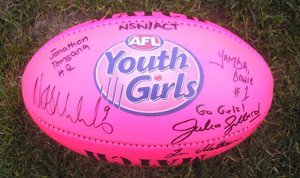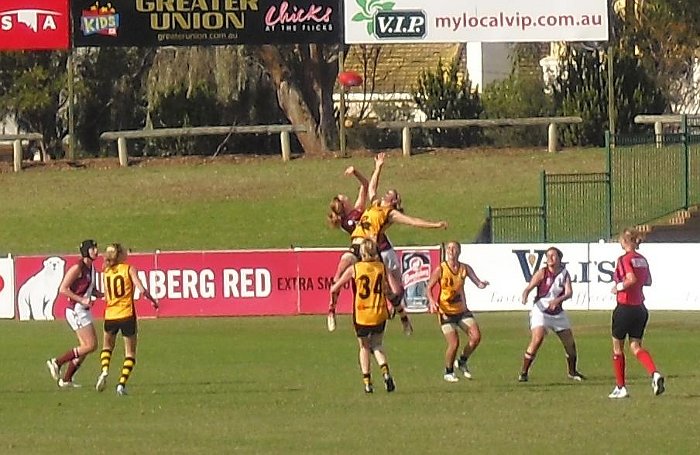The Future of Women’s Football in Australia
- Friday, July 22 2011 @ 10:40 am ACST
- Contributed by: Tobietta Rhyman
- Views: 5,064

 The target date set for the launch of an AFL backed national televised Women’s Australian Football League is 2020.
The target date set for the launch of an AFL backed national televised Women’s Australian Football League is 2020.
The date was originally set at 2013, with four to eight planned women’s teams set to become part of existing AFL teams, but after considering the amount of groundwork needed to organise it, and protests from Gold Coast and GWS that they would not have time to submit their bids in full, this was withdrawn. However, the AFL’s Female Football Development Manager, Jan Cooper, suggests that steps towards creating the competition need to be taken much earlier, with a trial run still possible in 2013.
The ultimate aim is to have an exciting product with skilled girls entertaining stadium goers and television audiences. In order to produce the talent level required, proper football pathways for women in every state need to be put in place years earlier, and the numbers of female coaches and umpires also needs to increase to support this. But there still has to be a viable competition structure for those left behind. There is a real possibility that without proper planning, existing local women’s leagues and clubs will face difficulties or even be forced to fold if they lose too many of their best players.
However, those same local leagues are the source of a lot of frustration, with league reps watching on almost helplessly as dates are put further and further out of reach from today’s top female talent. But the AFL is in the best position to recognise that beyond grassroots football, there are those in the wider world, such as important figures in media and possible sponsors, who needed convincing of the concept. Cooper is confident a 2013 trial is just the product to spark their interest, even if it’s just something based on the Women’s National Championships Division 1, with teams from the stronger states - Victoria, Western Australia, Queensland and New South Wales - taking part.
After the AFL has conducted a trial and a feasibility study it will be in a better position to decide on which model to adopt - whether to merge the women’s teams with the existing AFL clubs, or adopt an original identity. There is also a lot to discuss on whether to adopt AFL style policies for respect, responsibility and tribunals, or whether it should be based on policies in existing women’s leagues. But regardless on how they get there, the AFL is determined that by 2020 there will be a national televised women’s competition, with competing teams at least affiliated with existing AFL clubs, and with its own major sponsor. The AFL hopes this will lead to increased presence of female football in the media and in advertising. And similar to top level men’s football, the AFL also hopes to send the women’s ‘All Australian’ team to compete in an annual international competition, perhaps against female Gaelic Football players from Ireland, similar to the men’s International Rules, or even a World Women’s side, if the level of international women’s football can provide enough talented players to be competitive.
In order to back up the Women’s Australian Football League with continued input of young, top level players, and make existing women’s leagues sustainable, even without their top players, the AFL is hoping to boost the existing talent available in women’s football. By 2020, they hope at least 25% of local level football players are female, and that adequate player pathways, from Auskick to senior women’s football, exist in all state capitals and larger rural cities.
By 2030, efficient player pathways will be in place for girls in all state capitals and larger rural cities, ensuring that talented female players are given the same opportunities as boys to make it to the top levels of senior women’s football. This will start from girls’ Auskick, with hopes for at least 30% participation, followed by Junior Girls U10s and U12s available in larger metropolitan clubs, and at least U13s offered in less populated areas. U13s, U15s and U18s will be supported by all school sports associations.
An U16s and U18s Youth Girls competition will be set up in all state capitals, with at least 12-a-side U16s and U18s Youth Girls competitions available in larger rural cities. Following the Youth Girls, senior age female players can expect to play in established and consolidated leagues in larger rural cities, with expanding, multi-league competitions in state capitals affiliated with top level men’s football leagues and clubs (eg. AFL, SANFL, WAFL etc) Encouragingly, many of the AFL clubs already have ties with women’s clubs and leagues through support and sponsorship, such as Melbourne Football Club, which sponsors the VWFL.
In Cooper's vision for the future, football will be every bit as much a part of the Australian culture for women as it is for men, with girls growing up, not just watching the sport with their families, but playing the game with their friends too, maybe even dreaming of one day making the draft list, just like their brothers. If Cooper’s determination comes through, women’s teams playing each other in AFL club colours as a curtain raiser to the main AFL games could become a regular event. It would be as normal for women to start the day’s footy at the MCG, as for the reserves to kick off the NRL games across the railway tracks at AAMI Park. Cooper’s vision for the future of female football might be grand, but giving someone like her 10 years leaves us feeling confident that they can work it out.



 RSS news
RSS news Twitter
Twitter Facebook
Facebook